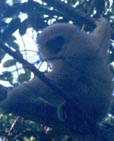Get
To Know
|
 The
White Handed Gibbon varies from black and dark-brown to light-brown,
sandy colours. Their hands and feet are white-coloured and a ring
of white hair surrounds the black face. They are true brachiators,
propelling themselves through the forest by swinging under the branches
using their extremely long arms and curved fingers on elongated
hands. They subsist principally upon fruit and leaves, with insects
and flowers forming the remainder of their diet in the dipterocarp
forest, including primary lowland and submontane rainforest, mixed
deciduous bamboo forest, and seasonal evergreen forest of Indonesia,
Laos, Malaysia, Myanmar and Thailand. Family groups inhabit a firm
territory, which they protect by warding off other gibbons with
their calls each morning. Each species has a typified call and each
breeding pair has unique variations on that theme. Mating occurs
in every month of the year, but most conceptions occur during the
dry season in March, with a peak in births during the late rainy
season, in October. On average, females reproduce for the first
time at about 11 years of age, gestation is six months long, and
pregnancies are usually of a single young. Young are nursed for
approximately two years, and full maturity comes at about eight
years. Their life expectancy is about 25 years. The white-handed
gibbon is threatened in various ways: they are sometimes hunted
for their meat, sometimes a parent is killed to capture young animals
for pets or to be imprisoned in zoos, but perhaps the most pervasive
is the loss of habitat through forest clearance for the construction
of roads, shifting agriculture, ecotourism, domesticated cattle
and elephants, forest fires, subsistence logging, illegal logging,
new village settlement, and palm oil plantations. The
White Handed Gibbon varies from black and dark-brown to light-brown,
sandy colours. Their hands and feet are white-coloured and a ring
of white hair surrounds the black face. They are true brachiators,
propelling themselves through the forest by swinging under the branches
using their extremely long arms and curved fingers on elongated
hands. They subsist principally upon fruit and leaves, with insects
and flowers forming the remainder of their diet in the dipterocarp
forest, including primary lowland and submontane rainforest, mixed
deciduous bamboo forest, and seasonal evergreen forest of Indonesia,
Laos, Malaysia, Myanmar and Thailand. Family groups inhabit a firm
territory, which they protect by warding off other gibbons with
their calls each morning. Each species has a typified call and each
breeding pair has unique variations on that theme. Mating occurs
in every month of the year, but most conceptions occur during the
dry season in March, with a peak in births during the late rainy
season, in October. On average, females reproduce for the first
time at about 11 years of age, gestation is six months long, and
pregnancies are usually of a single young. Young are nursed for
approximately two years, and full maturity comes at about eight
years. Their life expectancy is about 25 years. The white-handed
gibbon is threatened in various ways: they are sometimes hunted
for their meat, sometimes a parent is killed to capture young animals
for pets or to be imprisoned in zoos, but perhaps the most pervasive
is the loss of habitat through forest clearance for the construction
of roads, shifting agriculture, ecotourism, domesticated cattle
and elephants, forest fires, subsistence logging, illegal logging,
new village settlement, and palm oil plantations.
|
|
|
|
We have always gravitated towards things
that are tall. Tall mountains, tall people,
tall trees, big cocks. 5,000 years ago, when a man wanted
people to look up to him, he ordered the building of
tall pyramids, all statues, tall, phallic obelisks.
This is how we say
someone is important.
Even Jesus Christ is made taller,
and therefore, more important,
in our form of remembrance. The cross
adds another three or four feet
to his probably averaged-sized Mediterranean form.
The only time Jesus is pictured
off the cross
he's either perched on the back of an above-average-sized
donkey
or surrounded by very small children.
Perhaps it all comes down to
an obsession with male genitalia.
Man has the largest penis of the primate family,
and is damned proud of it. Just ask.
Perhaps this is why chimpanzees are satisfied
with fist-sized, practical tools made of twigs and blades
of grass
while men have to build skyscrapers.
Maybe if women had been the ones in charge
of the statues, and buildings, and theology
the major cities of the world would have entirely different-looking
skylines. We might all live underground, worshipping
at the mouths of dark caves, quivering flats of quicksand,
to a god that speaks out of oceanic whirlpools.
Or maybe the buildings would be built even taller.
Holly Day is a housewife and mother of two living in
Minneapolis, Minnesota who teaches needlepoint classes for the Minneapolis
school district and writing classes at The Loft Literary Center. Her
poetry has recently appeared in The Tampa Review, The Comstock
Review, and the St. Paul Almanac, and she is the 2011 recipient
of the Sam Ragan Poetry Prize from Barton College. Her most recent
published books are Walking Twin Cities and Notenlesen für
Dummies Das Pocketbuch.
|
 The
White-Handed Gibbon - Issue Seventeen
The
White-Handed Gibbon - Issue Seventeen